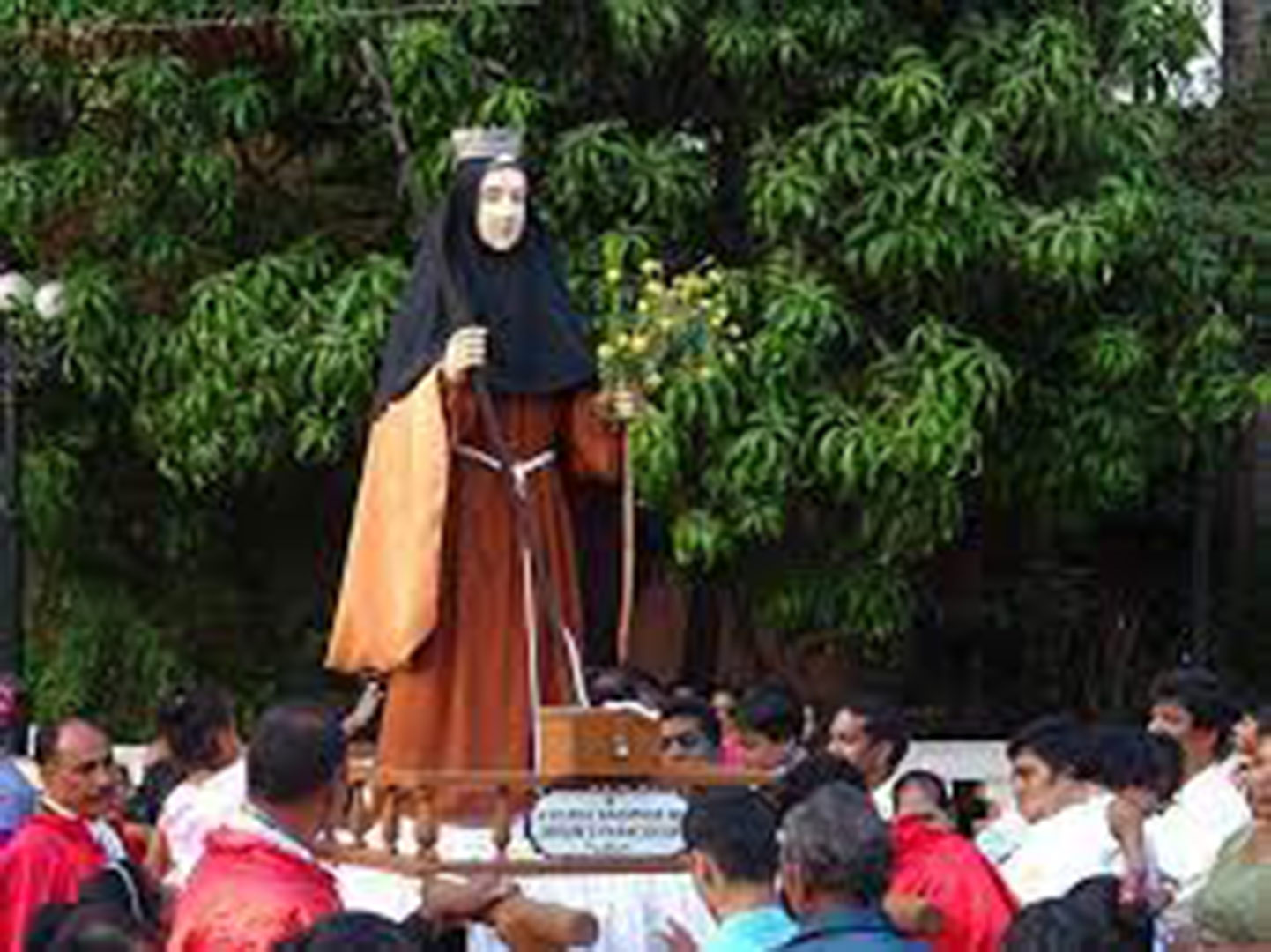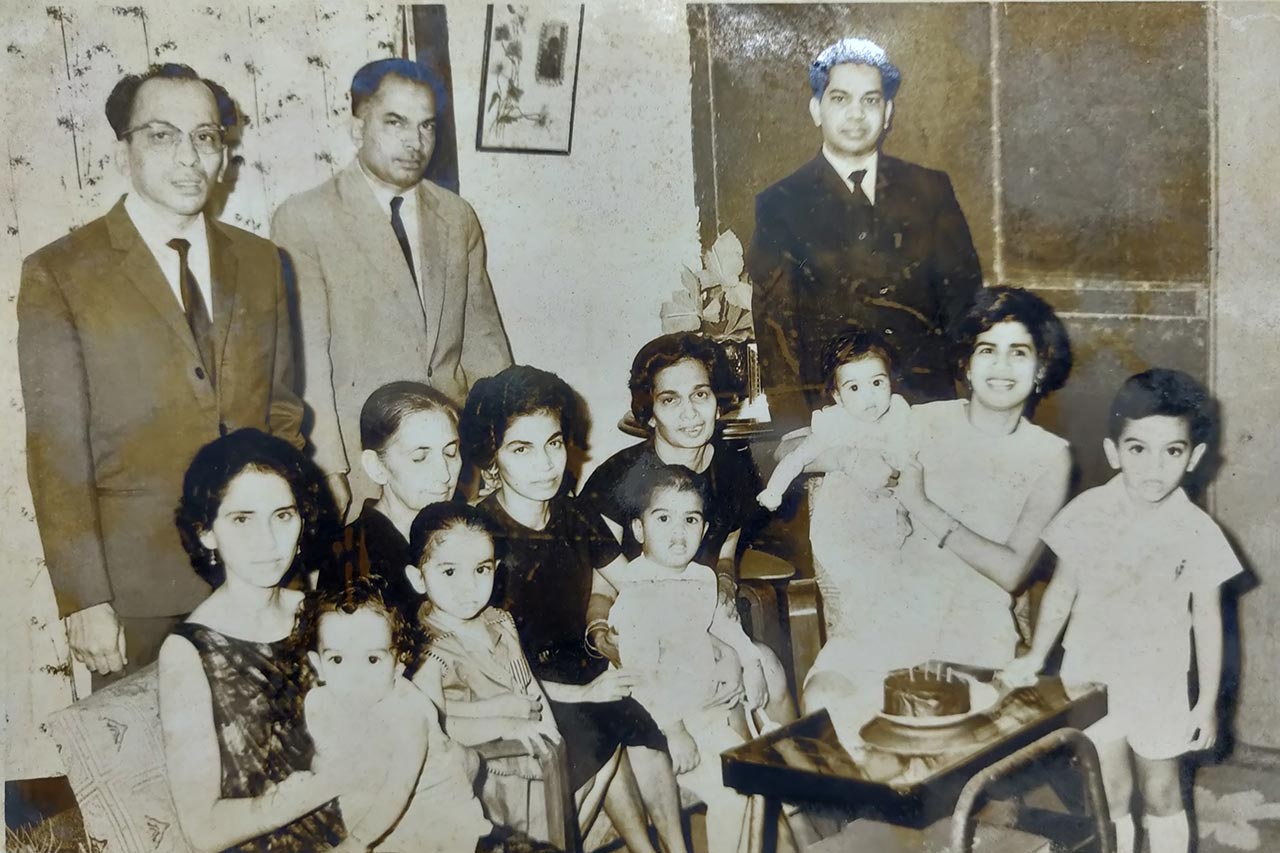Lenten Traditions in Goa
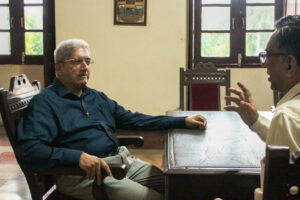
ON: What do you have to say about Goa's rich tradition of Lenten music?
JLP: Well, the Motetes (Motets) are Goa’s “classical” Lenten music. They began appearing by the middle of the 19th century. They were sung on the occasion of the Santos Passos (Holy Steps of the Cross) and also during the Sacred Triduum, that is, Maundy Thursday, Good Friday and Holy Saturday. This is Goan Lenten music par excellence. Enter Vatican II in the 1960s and as a result we now have many Lenten hymns – liturgical songs to be sung in church – all composed in the Konkani language, beginning from the year 1965.
ON: What might the earlier Lenten music have been, before the Motets came about in the middle of the 19th century?
JLP: I have no idea. They must have been only hymns in Latin because the liturgy was in Latin. The Parish Schools, for example, began in Goa way back in the 16th century. No Konkani music or hymns were taught there. It was only Latin. The students of our parish schools learnt even choral songs. They could sing in polyphony and they sang serious classical music, like Palestrina and later Perosi and others.
ON: The church Mestres (music teachers) must have also contributed a lot…
JLP: Yes, the Mestres of our Churches, who were also music teachers in our parish schools, used to compose a lot of music in Latin, especially Masses. I am from Benaulim and I met one or two Mestres in my childhood – one was Sabino Rebello and the other was some Roque whose surname I forget, who was the Mestre of St John the Baptist Church, Benaulim.
ON: Are there any studies on the Motets and the religious music of Goa?
JLP: Yes, there are certain studies made on the Motets. To my knowledge, one by Fr. Lourdino Barreto and the other by a Portuguese musicologist, Prof. Manuel Morais. Fr. Romeo Monteiro has published a booklet on this.
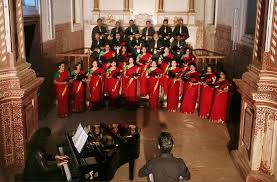
ON: Come to think of it, the Motet and the Mando belong to the same period!
JLP: Exactly, the Motet and the Mando came up in the second half of the 19th century. It was perhaps the fruit of what we could call a “compositional spurt” among Goan composers. At least for some hundred years in Goa, motets were composed in Latin. Perhaps in the nineteen fifties or a little earlier, they began composing motets in Konkani, like “Vell Mhozo Paulo” …
ON: Who composed it?
JLP: Look, we have a curious fact here. Manuel Morais has already found a number of motets, both in Latin and in Konkani, but there is no name of the composer!
ON: What could the reason be?
JLP: What he says is that perhaps the composers were few and widely known and hence there was no interest in knowing who had composed them.
ON: Let’s say, the composer of “Sam Francisku Xaviera”…
JLP: Raimundo Barreto! He is widely known for his iconic composition “Sam Francisku Xaviera”. I don’t know of any other composition by him. He probably has some.
ON: Would there be a way of collecting all the motets?
JLP: Yes. There are bound to be other motets, in private collections. Perhaps these Mestres, no longer alive today, have left in their trunks some other motets that are not known; but I doubt we shall ever know the names of the composers. That will be very difficult to find.
ON: So, at least regarding motets, we have surprises awaiting us…
JLP: I think so too.
ON: Let’s hope so! And now, let’s talk about music composed after the Vatican Council…
JLP: There are a number of composers, starting with Fr. Vasco do Rego. He was the pioneer of liturgical music in Konkani here in this diocese. We had religious songs in Konkani, even Lenten songs, which were not motets, like “Deva doiall kakutichea”, “Jezu mhojea tujer hanv patietam”. They are penitential hymns which most probably are one or even two centuries old. But the post-Conciliar impetus was given by Fr. Vasco do Rego. He composed many Lenten hymns and he was followed by others.
ON: And who would the others be?
JLP: Fr. Bernardo Cota, Fr. Lino de Sá, Fr. Santana Faleiro, Fr. Joe Rodrigues (this one is a junior priest, but has a couple of compositions)…
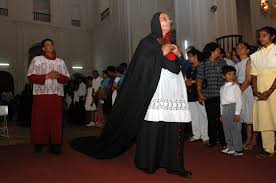
ON: And there must have been lay people…
JLP: Yes, there were lay people, too, like Alcântara Barros … and there was one who had been the Mestre of Verna church: I don’t remember his name.
ON: And Varela Caiado?
JLP: Well, I know Varela Caiado as the organist of our Cathedral in Old Goa. I don’t know him as a composer. I have no idea of any compositions by him. But he was a first-rate musician. He was the organist of our Cathedral: this is all I know of him.
ON: Are there productions of Lenten music brought forth by the Diocesan Commission for Sacred Music?
JLP: Yes, there are. I think there are at least two publications of Lenten sheet music, some loose leaflets, besides one or two audio compact discs.
ON: What would be some peculiarities of the Lenten rituals in Goa?
JLP: Well, we have traditions in Goa that are not followed elsewhere. First, the Santos Passos procession is something typical of Goa, and perhaps of a few other parishes which were part of the Diocese of Goa in times gone by, like Belgaum, Sawantwadi, Karwar: these places, which now belong to other dioceses, were part of the Archdiocese of Goa; so the Santos Passos are to be found there too. If one goes to Central India or South India or North India, no, no Santos Passos there. We have inherited this from Portugal, where the tradition still exists.
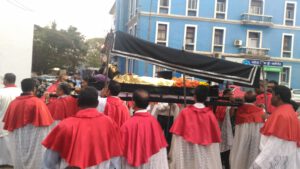
Here in Goa, the Santos Passos are an interesting event…. There are ‘two Goas’: North Goa and South Goa. In North Goa, Santos Passos are celebrated on every Sunday of Lent. If on the first Sunday of Lent one dwells on the Condemnation of Christ, the second Sunday is the Ecce Homo, on the third Sunday we have the Lord carrying the Cross, on the fourth Sunday, the Lord meeting his Mother on the way to Calvary, and so on: each Sunday offers a meditation on one of the Passos or steps of the Way of the Cross. They are not the fourteen stations, but just a few of them.
In South Goa, it is only one Sunday. For example, in Benaulim, it is the fifth Sunday, in Loutulim it is the third Sunday, and so on. Here you have only one procession of the Santos Passos, incorporating one or two or three Passos of the Way of the Cross.
Another tradition in Goa, both in North and South Goa: a child sings a Veronica hymn… Earlier on, the songs were only in Latin, but now there are Veronica songs in Konkani too.
ON: And the Procession of the Franciscan Saints?
JLP: Well, the Procession of the Terceiros: this too comes from Portugal! Here in Goa we know them as Terciários. In Portugal they are known as Franciscanos Terceiros or Franciscans of the Third Order. I wouldn’t know in which part of Portugal, but they still hold this procession of the Franciscan Saints over there. Here the procession is held only in one place: Goa Velha.
ON: But I’ve heard that Rome is the only other place where such a procession is held…
JLP: I’ve heard that too. If it’s true, I wouldn’t be able to say in which parish of Rome it is held. But I can tell you that there are a couple of parishes in Portugal where such a procession of Franciscan Saints is held: fourteen, fifteen andores (litters) are taken in procession, just like in Goa. But here, no longer are they Franciscan saints alone. There are other saints: Saint Joseph Vaz, the Patron of our Archdiocese, has already been added to the saints here. Don’t be surprised if one day the procession adds in Mother Teresa, Saint Teresa of Kolkata….
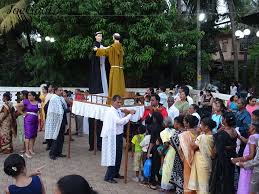
ON: But how did a Lenten procession of Franciscan Saints come about in the taluka of Ilhas or Tiswaddi, which was evangelized by the Dominicans?
JLP: Well, this procession, which takes place on the Monday following the Fifth Sunday of Lent, began in the Pilar Monastery, at a time when the Franciscan Capuchos lived there. When the Monastery was shut down, all those saints or images were lodged at the Parish Church of Goa Velha… Note that Pilar still belongs to the parish of Goa Velha, and it is this same parish that holds the procession every year.
ON: As we come to the end of this chat, may I ask you for a message for the season of Lent!
JLP: My message as a priest is that we should live the spirit of Lent as it should be: a spirit of penance, saying no to ourselves, all right, but not with ashes on our heads or sitting on sackcloth as they did in the Old Testament. Ours is a more joyful Lent, because the penance I make, I make it with love and with joy: I am anticipating the joy of the Lord’s Resurrection!
For the original audiovisual version in Portuguese, see Renascença Goa at https://www.youtube.com/watch?v=sXlnAoKU42M
English translation by the interviewee, at my request.
First published in Revista da Casa de Goa (Lisbon), Series II, Issue 9, March-April 2021 and here with a few additional inputs from the interviewee.
Surreal Tête-à-Tête
It was one of those nights when at first it looks as if nothing out of the ordinary is going to happen; but then, when one is already dead to the world – and can’t possibly expect anything to happen – almost everything happens.

Yes, in a dream anything can happen, triggered by a poignant scene witnessed earlier in the day, a gripping tale told or heard, or by interface of nostalgia and anticipation. For, as Eliot says in Four Quartets, “Time present and time past Are both perhaps present in time future, And time future contained in time past.”
The tête-à-tête I had on the second night of the New Year gave me the sense that “all time is eternally present, All time is unredeemable.” Time past and time present did get inextricably mixed when I was greeted by my grandmother Leonor (1900-1992), of happy and adorable memory.
While in real life it was grandma who waited for reports from the world of light, now it was my turn to seek news from beyond the tomb… about the Light of the World.
I was helping out at the funeral of a close relative when suddenly my Avó took centre stage. This was uncharacteristic of her, as like Mary in the Magnificat she always kept a low profile. In a coffin she lay – moved, quite oddly, to a busy commercial establishment at the Panjim church square, which was once called Largo das Flores, the Flower Square. But there were no flowers anywhere, no candles, no voices of mourning – only the din of the madding crowd and the motors outside.
It wasn’t an upsetting sight to behold, because the old lady herself was relaxed, seemingly waiting for a visitor to arrive. She had closed her eyes: I reckon she found no sense in doing otherwise after glaucoma had struck her blind in the last four years of her life.
My Brazilian friend Aluísio used to say, “When God sends you an illness, be sure He will also make the bed.” So it was for Avó, who had been blessed with an extra sense. She could literally feel the presence of a person in the room, although this time around she had mistaken me for Fernando, her firstborn and my father standing by her cradle. The cause of the confusion? Maybe my voice which sixteen years down the line has, so they say, grown closer to my father’s. But soon she said, radiantly, “Ah! It’s you, Oscar!”
The exclamation caused a gush of memories, like her grandchildren whom she always welcomed home – me in particular, every single day, after that gruelling journey to Quepem and back.
“Absolutely delighted to see you, Avó,” said I, feeling that sixteen years had telescoped into a day. While in real life it was grandma who waited for reports from the world of light, now it was my turn to seek news from beyond the tomb… about the Light of the World. I just could not wait and so, like a stuttering rifle’s rapid rattle, I fired a few questions:
“Avó, does God exist? Have you met Him? Spoken to Him? Where is He?”
That is when I noticed her standing upright. There was behind her a glass door as clear as crystal and sporting a red-and-yellow horizontal band; which opened onto the footpath. In stoic silence, with her eyes still shut and her smile withdrawn, she faced my inquiry. I thought briefly that my references to the divine had been brash, and was going to apologise; but the very next instant, perhaps misreading her stillness as endorsement of my momentary unbelief, I prodded her with more questions:
“Where is He? Up there, or down here? Were you there?”
An inquisitorial Pilate got no answers from Jesus, did he? The same here; and, in addition, I was woken up. In vain did I try to recover that magical ambience of suspended consciousness, by burying my face deep in my pillow! There was also that enigmatic lady in a green sari, who was babbling a few nothings in her bid to liaise between my grandmother and me; but again, to no avail.
Fled was that vision, the saving grace being the sound of music about my ears: later I identified it as “Jezu, Ballka Pritichea” (‘Our Dear Child Jesus’) – a solemn polyphonic composition by our very own Fr. Vasco do Rego. (On waking up I was divided between that hymn and Fr Peter Cardozo's vivacious "Zoi Jezu, Amcheá Raza", meaning 'Hail, O Christ, Our King!'')
By now the sparrows outside had begun their chirpy melody, while the inside of me thumped like a drum. Hailing that hymn as a sweet reply to my impatient musings, I realised that it was nearing the Angelus, a moment very close to Avó’s heart. I was gradually coming to terms with my intimate reality, confident that it had disturbed no one, but soon thereafter, pretty shaken up was I when my firstborn, Fernando Jr., waking up as usual at seven o’clock, asked quite matter-of-factly, “Papa, whose funeral did you attend yesterday?”
(Herald, 9 February 2009)
